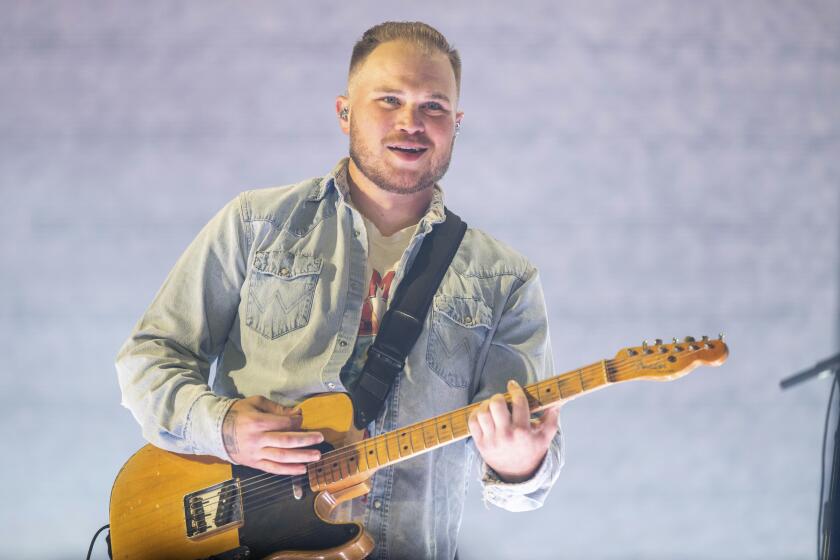L.A. Phil tries something new with Green Umbrella Concert
Now it’s L.A.’s turn.
Having been much intrigued in recent seasons by the burgeoning Brooklyn new music scene, the Los Angeles Philharmonic decided to stick closer to home for new material Tuesday night for the orchestra’s New Music Group’s Green Umbrella Concert.
The theme of a program of four works selected and conducted by John Adams was local young composers working around the corner from Walt Disney Concert Hall. The neighborhood is, after all, now hopping with concerts at loft spaces and galleries downtown and nearby Koreatown and Echo Park. But the Brooklyn/L.A. divide is not in the end all that clear cut.
Two years ago, Adams premiered “Try” by Andrew Norman — one of the hotter young composers and this year a Pulitzer Prize finalist — on a Green Umbrella program devoted to young Brooklynites. “Try” was back Tuesday now as an Angeleno score. Having moved to New York after graduating from USC, Norman has returned to USC to teach. He is also the current Los Angeles Chamber Orchestra composer-in-residence.
PHOTOS: Arts and culture in pictures by The Times
The other composers on Tuesday’s program are also regulars on LAX/JFK flights. And the discussion in the pre-concert talk with the composers and Adams was all about the new migration west. Brooklyn, the consensus seemed, has gotten too expensive, crowded and too much a hipster haven of conformity.
Sean Friar, whose “Little Green Pop” went into the previous unexamined genre of alien pop, noted that composers come to L.A. for independence. Julia Holter, whose “Memory Drew Her Portrait” brought a medieval sensibility to pop song (or maybe it was the other way around), also spoke of having in L.A. both the physical and artistic space to make what she wants.
Norman said that, unlike in Brooklyn where everybody is watching everybody else, in L.A. you have the freedom to try new things out, take risks and fail. Andrew McIntosh, whose Etude IV explored microtones with exciting obsessiveness, said this is the town where you get to build things from the ground up and don’t have to worry about institutional interference.
Even so, these four free spirits, who were born between 1979 and 1985, seemed only too happy to have a smidgen of support from the biggest symphonic institution in the country, and all agreed that the L.A. Phil’s ever-increasing focus on new music is proving a catalyst to the local scene at large.
And sure enough, REDCAT, below Disney, had a fascinating, competing new music program Tuesday, with new works by Angelenos and others written for noise intoners, instruments invented by Italian Futurists a century ago (I was able to catch the last five minutes, and what a wow they were).
FULL COVERAGE: Walt Disney Concert Hall at 10
Upstairs, the four Green Umbrella works went their own intriguing ways exactly as advertised.
Friar’s alien pop merrily waved off worries by physicist Stephen Hawking, who has warned that if there is life on other planets we have no reason to expect it to be friendly. “Little Green Pop” — for two saxophones, trombone, piano, percussion and electric guitar — deconstructs conventional pop formulas in bouncy, broken, suddenly excitable explosions bounding up scales and down and meant to evoke little green men at their most endearingly danceable.
Holter, a singer and songwriter who also radically toys with pop convention, intoned her new piece (an L.A. Phil commission) with breathy, broken phrases. Her voice amplified with an echoing reverb that sounded intimate and remote at the same time, as though she were whispering into a thousand ears.
As a performer, she proved a rapt 21st century troubadour capturing the sensuality in song of a lost lover. The chamber orchestra, however, evoked the love songs of the 14th century French radical Guillaume de Machaut with sparse harmonies and lush instrumental resonance.
I’d play McIntosh’s Etude IV from “Symmetry Etudes” — written for the odd combination of two clarinets and violin — for the little green men were they to show up.
In this process piece, evenly paced notes begin in unison and gradually come apart harmonically as the instruments move apart microtonally, that is to say finding themselves swimming in pitches between the notes of the piano. The harmonies are ones not heard before. Some, I’m told, found this an annoying Angeleno risk. I thought it a splendid adventure.
Norman’s “Try,” for large ensemble, is a goof that works. It begins bopping amusingly in many messy directions at once. It eventually finds its way but is never totally sure of itself. The piano, more than once, stops everything with antic effect and no answers. The wit is strong. So is the complexity and rhythmic elation. The honking horns and the touristy insecurity made me think of it as an “Angeleno in Brooklyn.”
Adams said he looked at a hundred scores between picking these four. He then threw himself into them, conducting with punch-drunk rhythmic verve — an excellent job of music salesmanship.
More to Read
The biggest entertainment stories
Get our big stories about Hollywood, film, television, music, arts, culture and more right in your inbox as soon as they publish.
You may occasionally receive promotional content from the Los Angeles Times.










